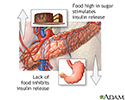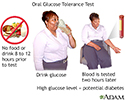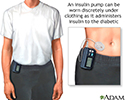Diabetic ketoacidosis
DKA; Ketoacidosis; Diabetes - ketoacidosis
Diabetic ketoacidosis is a life-threatening problem that affects people with diabetes . It occurs when the body cannot use sugar (glucose) as a fuel source because there is no insulin or not enough insulin. Fat is used for fuel instead.
Diabetes
Diabetes is a chronic disease in which the body cannot regulate the amount of sugar in the blood.

When fat is broken down to fuel the body, chemicals called ketones build up in the body.
Causes
As fat is broken down, acids called ketones build up in the blood and urine. In high levels, ketones are poisonous. This condition is known as ketoacidosis.
Diabetic ketoacidosis (DKA) is sometimes the first sign of type 1 diabetes in people who have not yet been diagnosed. It can also occur in someone who has already been diagnosed with type 1 diabetes. Infection, injury, a serious illness, missing doses of insulin shots, or surgery can lead to DKA in people with type 1 diabetes.
People with type 2 diabetes can also develop DKA, but it is less common. It is usually triggered by uncontrolled blood sugar, missing doses of medicines, or a severe illness.
Type 2 diabetes
Type 2 diabetes is a lifelong (chronic) disease in which there is a high level of sugar (glucose) in the blood. Type 2 diabetes is the most common f...

Symptoms
Common symptoms can include:
-
Decreased alertness
Decreased alertness
Decreased alertness is a state of reduced awareness. A coma is a state of decreased alertness from which a person cannot be awakened. A long-term co...
Read Article Now Book Mark Article -
Deep,
rapid breathing
Rapid breathing
Hyperventilation is rapid and deep breathing. It is also called overbreathing, and it may leave you feeling breathless.
Read Article Now Book Mark Article - Dry skin and mouth
- Flushed face
-
Frequent urination
or
thirst that lasts for a day or more
Frequent urination
Frequent urination means needing to urinate more often than usual. Urgent urination is a sudden, strong urge to urinate. This causes a discomfort i...
 ImageRead Article Now Book Mark Article
ImageRead Article Now Book Mark ArticleThirst that lasts for a day or more
Excessive thirst is an abnormal feeling of always needing to drink fluids.
 ImageRead Article Now Book Mark Article
ImageRead Article Now Book Mark Article - Fruity-smelling breath
- Headache
-
Muscle stiffness or aches
Muscle stiffness or aches
Muscle aches and pains are common and can involve more than 1 muscle. Muscle pain also can involve ligaments, tendons, and fascia. Fascia are the s...
 ImageRead Article Now Book Mark Article
ImageRead Article Now Book Mark Article -
Nausea
and vomiting
Nausea
Nausea is feeling an urge to vomit. It is often called "being sick to your stomach. "Vomiting or throwing-up is forcing the contents of the stomach ...
 ImageRead Article Now Book Mark Article
ImageRead Article Now Book Mark Article -
Stomach pain
Stomach pain
Abdominal pain is pain that you feel anywhere between your chest and groin. This is often referred to as the stomach region or belly.
 ImageRead Article Now Book Mark Article
ImageRead Article Now Book Mark Article
Exams and Tests
Ketone testing may be used in type 1 diabetes to screen for early ketoacidosis. The ketones test is usually done using a urine sample or a blood sample .
Urine sample
A ketone urine test measures the amount of ketones in the urine.
Blood sample
A serum ketone test measures how many ketones are there in the blood.

Ketone testing is usually done when DKA is suspected:
- Most often, urine testing is done first.
- If the urine is positive for ketones, most often beta-hydroxybutyrate is measured in the blood. This is the most common ketone measured.
Other tests for ketoacidosis include:
-
Arterial blood gas
Arterial blood gas
Blood gases are a measurement of how much oxygen and carbon dioxide are in your blood. They also determine the acidity (pH) of your blood.
 ImageRead Article Now Book Mark Article
ImageRead Article Now Book Mark Article - Basic metabolic panel, (a group of blood tests that measure your sodium and potassium levels, kidney function, and other chemicals and functions)
- Blood glucose test
- Blood pressure measurement
Treatment
The goal of treatment is to correct the high blood sugar level with insulin. Another goal is to replace fluids lost through urination, loss of appetite, and vomiting if you have these symptoms.
If you have diabetes, it is likely your health care provider told you how to spot the warning signs of DKA. If you think you have DKA, test for ketones using urine strips or your glucose meter. If ketones are present, call your provider right away. DO NOT delay. Follow any instructions you are given.
It is likely that you will need to go to the hospital. There, you will receive insulin, fluids, and other treatment for DKA. Then doctors will find and treat the cause of DKA, such as an infection.
Outlook (Prognosis)
Most people respond to treatment within 24 hours. Sometimes, it takes longer to recover.
If DKA is not treated, it can lead to severe illness or death.
DKA
Acidosis is a condition in which there is too much acid in the body fluids. It is the opposite of alkalosis (a condition in which there is too much ...

Possible Complications
Health problems that may result from DKA include any of the following:
- Fluid buildup in the brain (cerebral edema)
-
Heart stops working (
cardiac arrest
)
Cardiac arrest
Cardiac arrest occurs when the heart suddenly stops beating. When this happens, blood flow to the brain and the rest of the body also stops. Cardia...
Read Article Now Book Mark Article -
Kidney failure
Kidney failure
Acute kidney failure is the rapid (less than 2 days) loss of your kidneys' ability to remove waste and help balance fluids and electrolytes in your b...
 ImageRead Article Now Book Mark Article
ImageRead Article Now Book Mark Article
When to Contact a Medical Professional
DKA is often a medical emergency. Call your provider if you notice symptoms of DKA.
Go to the emergency room or call the local emergency number (such as 911) if you or a family member with diabetes has any of the following:
- Decreased consciousness
- Fruity breath
- Nausea and vomiting
- Trouble breathing
Prevention
If you have diabetes, learn to recognize the signs and symptoms of DKA. Know when to test for ketones, such as when you are sick.
If you use an insulin pump, check often to see that insulin is flowing through the tubing. Make sure the tube is not blocked, kinked or disconnected from the pump.
References
Pasquel FJ, Umpierrez GE. Hyperglycemic crises. In: Jameson JL, De Groot LJ, de Kretser DM, et al, eds. Endocrinology: Adult and Pediatric . 7th ed. Philadelphia, PA: Elsevier Saunders; 2015:chap 46.
Standards of Medical Care in Diabetes-2016: Summary of Revisions. Diabetes Care . 2016:39;Suppl 1:S4-S5. PMID: 26696680 www.ncbi.nlm.nih.gov/pubmed/26696680 .
Westerberg DP. Diabetic ketoacidosis: evaluation and treatment. Am Fam Physician . 2013;87(5):337-46. PMID: 23547550 www.ncbi.nlm.nih.gov/pubmed/23547550 .
-
Food and insulin release - illustration
Insulin is a hormone secreted by the pancreas in response to increased glucose levels in the blood.
Food and insulin release
illustration
-
Oral glucose tolerance test - illustration
During the oral glucose tolerance test your blood glucose is tested two hours after drinking 75 grams of glucose. You are diagnosed with diabetes if your blood glucose level is 200 mg/dl or greater.
Oral glucose tolerance test
illustration
-
Insulin pump - illustration
Various styles of insulin pumps may be utilized by people with diabetes to inject insulin into the body in a controlled, more convenient and discreet manner.
Insulin pump
illustration
-
Food and insulin release - illustration
Insulin is a hormone secreted by the pancreas in response to increased glucose levels in the blood.
Food and insulin release
illustration
-
Oral glucose tolerance test - illustration
During the oral glucose tolerance test your blood glucose is tested two hours after drinking 75 grams of glucose. You are diagnosed with diabetes if your blood glucose level is 200 mg/dl or greater.
Oral glucose tolerance test
illustration
-
Insulin pump - illustration
Various styles of insulin pumps may be utilized by people with diabetes to inject insulin into the body in a controlled, more convenient and discreet manner.
Insulin pump
illustration
Review Date: 7/24/2015
Reviewed By: Brent Wisse, MD, Associate Professor of Medicine, Division of Metabolism, Endocrinology & Nutrition, University of Washington School of Medicine, Seattle, WA. Internal review and update on 09/01/2016 by David Zieve, MD, MHA, Isla Ogilvie, PhD, and the A.D.A.M. Editorial team.



